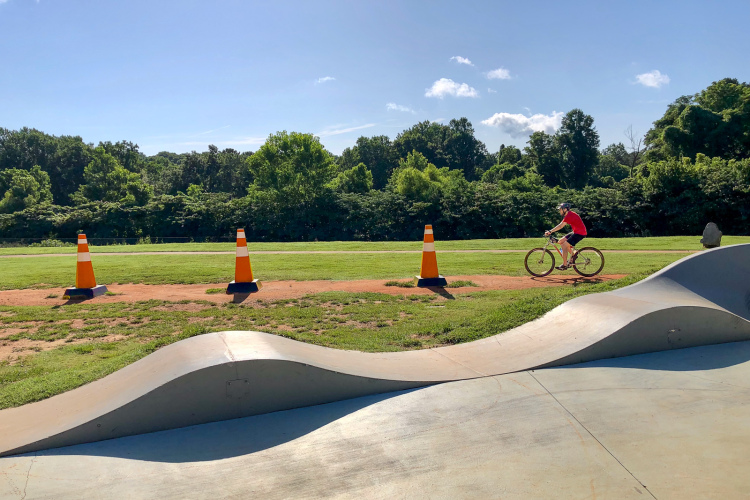
The fifth-generation Devinci Troy Carbon is here, and like the fifth-generation alloy Troy released in the fall, it features some welcome course corrections. Gone is the dated kinked top tube design, Super Boost Plus rear hub spacing, and the portly 34.9mm diameter seat tube. Not only that, riders will be stoked on new features like in-frame storage, updated geo, increased suspension travel, and the ability to run mixed wheels. A lot has changed since the carbon Troy was last updated in 2020, and this refresh proves it.


Out with the old
Easily the most noticeable change is the top tube on the Devinci Troy Carbon frame. The new Troy Carbon ditches the dated, kinked design from the previous generation in favor of a straighter, more modern-looking silhouette that finally brings it in line with its alloy sibling—and with current design trends in general. With the straight top tube, the standover height on the new Troy is even lower than the previous version for all frame sizes. In fact, the standover height is the same for the size small frame as it is for the size extra large!
“The standover height remains the same across all sizes because the junction where the top tube meets the seat tube is fixed at the same vertical position in space,” said Bastien Major, Sports and Product Marketing Manager for Devinci. “It’s an intentional design choice that maximizes clearance. In contrast, the seat tube length (from this point to upper end) increases with frame size to provide proper fit and pedaling position for riders of different heights.”
One of the biggest changes is the move away from Super Boost Plus rear spacing. While the 157mm axle standard promised improved tire and chainring clearance and greater stiffness, it never quite gained mainstream traction. The updated Troy Carbon reverts to regular Boost 148 spacing, which means better parts compatibility.

However, with that shift comes some trade-offs: tire clearance is now capped at 2.5 inches for 29er tires (down from 2.6 inches), and the maximum chainring size drops from 36T to 34T.
In another nod to rider preference, Devinci has switched from a 34.9mm to a 31.6mm seatpost, making it easier to find dropper options and potentially saving grams in the process. A few years ago, stiffer, 34.9mm diameter seatposts were pitched as a new standard that would allow for longer travel posts. However, today’s long-travel posts — up to 250mm — are generally offered in the more popular 30.9mm and 31.6mm diameters, and seem to perform just fine.

In with the new
Like the aluminum model, the carbon Troy finally includes in-frame storage, giving riders space to stash tools and snacks without resorting to bags or straps. It also adopts the Universal Derailleur Hanger (UDH) standard and is fully compatible with SRAM’s T-Type transmission. Both builds on offer make use of SRAM direct-mount derailleurs. We’re a little surprised Devinci doesn’t have a Shimano XTR build available, given the timing of the Troy launch.
Geometry-wise, the new Troy is highly adaptable. Riders can run a full 29er setup or a mixed-wheel build without altering the geometry, thanks to a flip chip at the lower shock mount. The same chip can also be used to toggle between high and low geometry settings when running matched 29-inch wheels.

The Devinci Troy Carbon features a slacker head tube angle on the latest models, along with a longer wheelbase. Seat tube angles are roughly the same, although at the smaller sizes, the seat angle is slightly steeper this time around. Devinci was one of the first brands to offer size-specific chainstays, and we see the same with the latest Troy Carbon frames. Chainstay lengths range from 432mm on small frames up to 445mm on extra-large frames.
Along with the geo updates, Devinci is giving the Troy 160/150mm of suspension travel front and rear. This brings the carbon version in line with the alloy frame, which was updated late last year.
In terms of the suspension design, the frame still uses Dave Weagle’s patented Split Pivot setup, now updated with new kinematics to improve traction and support deeper in the stroke. This design is functionally similar to Trek’s ABP system in that it’s designed to isolate braking forces from suspension movement.
“With the increase in rear travel and a longer shock stroke, the entire [leverage] curve has shifted slightly upward,” Major told Singletracks. “This results in a slightly more supple feel at the beginning of the travel, improving small-bump sensitivity. That said, end-of-stroke support remains consistent with the previous design, ensuring the bike still offers strong bottom-out resistance / good progressivity / coil shock compatibility. As for mid-stroke behavior, it remains very similar to the previous version, maintaining the same supportive and balanced ride character the Troy is known for.”

Two builds are available at launch: a SRAM GX Eagle Transmission kit for $6,499 USD and a SRAM Eagle 90 model for $5,399. Compare that to similar builds for the aluminum Troy, priced at $6,149 and $5,499, respectively, and the carbon frame looks like a great deal. In the case of the Eagle 90 build, buyers are actually saving money by going with carbon over aluminum. However, though the drivetrains are the same, the aluminum build has slightly upgraded suspension and brakes. Also, the aluminum frames are made in Canada, which buyers will appreciate, though this likely adds a bit to the cost.
Devici says the Eagle Transmission build weighs about 33.1lb for a size medium bike, while the less expensive Eagle 90 build weighs more than a pound less at 31.9lb.











2 Comments
Jun 8, 2025
https://www.pinkbike.com/u/redfoxrun/blog/tale-of-two-trail-bikes.html
Jun 10, 2025